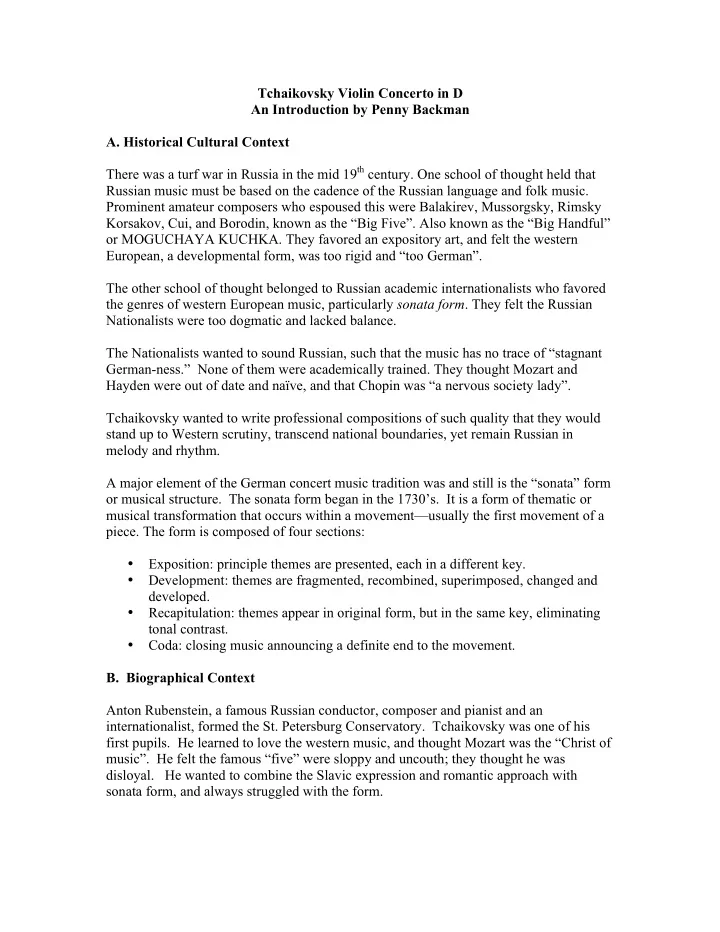

Tchaikovsky Violin Concerto in D An Introduction by Penny Backman A. Historical Cultural Context There was a turf war in Russia in the mid 19 th century. One school of thought held that Russian music must be based on the cadence of the Russian language and folk music. Prominent amateur composers who espoused this were Balakirev, Mussorgsky, Rimsky Korsakov, Cui, and Borodin, known as the “Big Five”. Also known as the “Big Handful” or MOGUCHAYA KUCHKA. They favored an expository art, and felt the western European, a developmental form, was too rigid and “too German”. The other school of thought belonged to Russian academic internationalists who favored the genres of western European music, particularly sonata form . They felt the Russian Nationalists were too dogmatic and lacked balance. The Nationalists wanted to sound Russian, such that the music has no trace of “stagnant German-ness.” None of them were academically trained. They thought Mozart and Hayden were out of date and naïve, and that Chopin was “a nervous society lady”. Tchaikovsky wanted to write professional compositions of such quality that they would stand up to Western scrutiny, transcend national boundaries, yet remain Russian in melody and rhythm. A major element of the German concert music tradition was and still is the “sonata” form or musical structure. The sonata form began in the 1730’s. It is a form of thematic or musical transformation that occurs within a movement—usually the first movement of a piece. The form is composed of four sections: • Exposition: principle themes are presented, each in a different key. • Development: themes are fragmented, recombined, superimposed, changed and developed. • Recapitulation: themes appear in original form, but in the same key, eliminating tonal contrast. • Coda: closing music announcing a definite end to the movement. B. Biographical Context Anton Rubenstein, a famous Russian conductor, composer and pianist and an internationalist, formed the St. Petersburg Conservatory. Tchaikovsky was one of his first pupils. He learned to love the western music, and thought Mozart was the “Christ of music”. He felt the famous “five” were sloppy and uncouth; they thought he was disloyal. He wanted to combine the Slavic expression and romantic approach with sonata form, and always struggled with the form.
On July 18, 1875, at age 37, Tchaikovsky married one of his former students. He wrote to his brother Modest that he was terrified of exposure of his homosexuality, and would put a stop to gossip by marrying. He was desperately unhappy and ended the marriage after 3 months. At the same time he had a very satisfying relationship, consisting solely of an exchange of letters, with a wealthy widow, Nadezhda Von Meck. When he divorced, she offered him a substantial stipend to allow him to devote all his time to composing. He immediately rented the Villa Richeleu in Clarins, Switzerland, on Lake Geneva, and began to write the Violin Concerto. With him was Josef Kotek, a famous violinist and former lover. C. Musical Analysis of Tchaikovsky’s Violin Concerto The concerto has a first movement in sonata form. But it has been called a “quirky” sonata form. • It begins with an elegant melody, played twice and then, never again. That would be what got him in trouble with the academicians because it had no connection to anything that follows. • Next comes the unearthly beautiful first theme, and, true to sonata form, a modulating bridge, paving the way to a second theme. His second theme, played con molto expressivo , is a melody showing Slavic melancholy, played with spare orchestral accompaniment. • The development section is based entirely on the first theme. It is not taken apart and explored as usual in a sonata form development. It does not become different. Instead you hear repetitions, and subtle, but noticeable changes in the rhythm or phrasing, counterpoint, and varying of instruments. According to Brown, his biographer, this development section increases the dramatic tension and emotional experience by changing backgrounds for example, using various instrumental dialogues. • Next, listen for a violin cadenza, which concludes into the recapitulation, opened by a flute solo. • The coda introduces new music. Another little stray from the sonata form. The second and third movement follow, with no break in between. • Listen for the second movement, andante, which is a Slavic folk song. Back to Russian nationalism. • The third movement is a Slavic dance with a short phrase repeated six times, faster and faster and louder, and wilder, making the violin catch fire. Again, it is very Russian to have a folk dance and repeat the phrases. D. First Performance and Critical Reception of the Concerto Tchaikovsky wanted to dedicate the concerto to Josef Kotek and offer him the premier of the concerto, but hesitated fearing malicious gossip. He offered the piece to Leopold
Auer, who refused to play it, saying it was impossible to play. Tchaikovsky then offered it to Kotek who had been offended at not being asked first, saying it was impossible to play, even though he had played it throughout the composing of it. It was then offered to Adolph Brodsky, who played it beautifully. The reviews from all sides were bad: “vulgar” “we smell vodka” “music stinks to the ear” “shredding the violin”. Leopold Auer played it subsequent to the first concert, and taught it to his pupils, among them, Jascha Heifitz. Today, the violin concerto is a favorite concert piece.
Recommend
More recommend